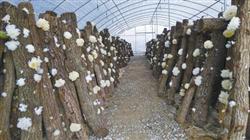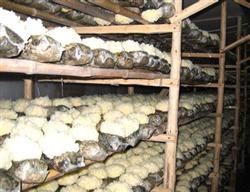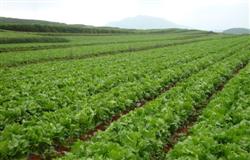How to produce the strain of Tremella fuciformis

The mycelium of Tremella fuciformis and the mycelium of incense ash were isolated and cultured separately in the test tube by ㈠ mother seed and original seed. When producing the mother seed, the mycelium of Tremella fuciformis was first removed and expanded to the required number of tubes. Then cultured at 25 ℃, the colony diameter of Tremella fuciformis was about lcm. At this time, in each test tube with Tremella mycelium, a very small amount of ash mycelium is inoculated, and when the two grow together, they can be sold or used in the original seed production. If you first connect the ash mycelium, because the incense ash mycelium grows fast, it quickly covers the slope, and quickly consumes nutrients, and then the Tremella mycelium is not easy to grow. If the mycelia of Fraxinus mandshurica and Tremella fuciformis are inoculated in a test tube at the same time, there will also be a small number of mycelia and a large number of mycelia of Tremella fuciformis. Therefore, when producing Tremella fuciformis mother seed (test tube seed), we must pay attention to the sequence of inoculation and pay attention to control the ratio of the two. ㈡ Tremella fuciformis and its associated bacteria can be planted artificially in food and medicine. At present, only Tremella fuciformis and Tremella fuciformis belong to this type of bacteria. For the formation of their fruiting bodies, Tremella fuciformis must not only have pure Tremella mycelium, but also have the help of "concomitant bacteria", that is, Cinnamomum cinerea; Tremella fuciformis must not only have pure Tremella mycelium, but also have the help of Streptomyces coarse hairs, both of which are indispensable. Under general conditions, the pure mycelium of Tremella fuciformis and Tremella fuciformis grow very slowly, and their ability to decompose lignin and cellulose is very weak, which depends on the decomposition matrix of ash mycelium and rough leather mycelium, respectively, to provide nutrients for their growth and development. otherwise, it would be impossible to form a fruiting body. Therefore, in the propagation of Tremella fuciformis and Tremella fuciformis, the two corresponding mycelium must be transferred to the same medium for mixed culture. Taking Tremella fuciformis as an example, this paper introduces the mixed seed production techniques of two kinds of mycelium: 1. In the slant mother-seed mixing method (Fig. 33-1), a pure Tremella mycelium test tube and a newly prepared PDA slant test tube were put into the inoculation room (box) together with the inoculation apparatus, and transferred according to the aseptic operation, that is, a piece of rice grain size with culture medium was transferred to the blank test tube bevel culture medium and cultured at constant temperature for 6-8 days under 22-24 ℃ after adding cotton plug. When the mycelium of Tremella fuciformis grows to the size of embroidered ball such as soybeans, and then moved into the inoculation room (box) together with the mother seed of incense ash, the inoculation shovel is about 2 cm away from the pure mycelium of Tremella fuciformis according to the aseptic action, and a small piece of white mycelium is inserted into it. After 2 days of culture, the white mycelium can be seen on the inoculation block, and the white hairs will be formed in about 7 days to cover the pure mycelium of Tremella fuciformis. For 12-15 days, red and yellow water droplets can be seen above the white hair mass as success. It should be pointed out that when using the mixed mother species of Tremella fuciformis and Botrytis cinerea to enlarge the original species, the front and rear ends of the slope should be cut off, and only the pure white mycelium of Tremella fuciformis and the nearby black-gray mycelium should be used for transfer. Therefore, one bevel mother seed can only receive one bottle of original seed. Fig. 33-1 mixing method of bottled sawdust original seed mixing method (Fig. 33-2) if there is no pure mycelium of Tremella fuciformis, the spores of Tremella fuciformis are cultured into spore mother species, and then mixed with the mother species of Botrytis cinerea made from bottled sawdust medium. According to the inoculation requirement, according to the proportion of 12-15 bottles of sawdust culture medium expanded by one incense ash slant mother seed, the test tube, sterilized bottle sawdust medium and inoculation utensils were put into the inoculation box together, according to aseptic operation, a soybean-sized Botrytis cinerea mother seed was selected with an inoculation shovel and inserted into the sawdust culture medium bottle. After inoculation, the white hyphae were cultured at 24-26 ℃. After about 2 days, the white hyphae germinated on the inoculum. After that, it should be checked every other day, and the miscellaneous bacteria should be detected and eliminated in time. After about 11 days of culture, the ash hyphae can extend about 3 cm into the culture medium, and grayish brown or dark brown secretions can be observed on the surface of the culture medium, which indicates that the ash mycelium grows vigorously and should be connected with Tremella fuciformis spore mother species in time. According to the ratio of 1:12 to 15, the test tube of Tremella fuciformis and the cultured sawdust culture medium were put into the inoculation room (box). According to aseptic operation, the surface layer of incense ash mycelium was cut with aseptic inoculation knife, and then a small amount of Tremella fuciformis spores were picked out with aseptic inoculation shovel and inserted into the mycelium of incense ash (Fig. 33-2). After mixing, the flask was moved to 23-25 ℃, and the thick white hyphae could be seen in the spores of Tremella fuciformis after about 10 days. Red and yellow water droplets appeared after about 18 days of culture, and kink fruiting body primordia could be observed after 25 days, indicating that the culture was successful. One bottle of such sawdust mixed species can be expanded to 30-40 bottles of original species (secondary species). Fig. 33-2 original seed mixing method of bottled sawdust 1. Spores of Tremella fuciformis; 2. Botrytis cinerea 3. Cut the surface layer of incense gray fungus; 4. Pick out spores of Tremella fuciformis; 5. According to the growth of the original seed, the size of the ear base and the "feeding" depth of the mycelium of Tremella fuciformis, the production of ㈢ seeds in the bottle determines the number of bottles that should be expanded in each bottle. In order to ensure the quality, try to control within 40-60 bottles. If the original seed can be stirred evenly, so that the mycelium of Tremella fuciformis and ash mycelium mix evenly, each bottle of original seed may also be planted in 100-200 bottles. ㈣ precautions to produce excellent strains of Tremella fuciformis, in addition to paying attention to the above requirements, such as aseptic operation, we must also pay attention to the following aspects: 1. The combination of bio-specific Tremella fuciformis mycelium and ash mycelium is also specific. Therefore, in order to produce effective strains of Tremella fuciformis, we must obtain pure culture of Tremella fuciformis (including yeast-like conidia or mycelium of Tremella fuciformis) and pure ash hyphae from the same fungus. The mycelia of Tremella fuciformis and ash obtained from different ear trees (tree species) in different regions or the same area can not be exchanged and combined at will. Otherwise, there is the possibility of decline. The effect of the exchange and combination must be judged according to the colonization of the mycelium of Tremella fuciformis in the sawdust medium, as well as the size and opening of the ear base. If the mycelium of Tremella fuciformis can continue to grow, form the ear base and open the film smoothly, it can continue to be expanded and used in production, otherwise it can not be used. Inoculation ratio: according to the characteristics of slow mycelium growth of Tremella fuciformis and rapid growth of ash mycelium, we must pay attention to the inoculation ratio of Tremella mycelium and ash mycelium in pure mixed culture. In order to control the inoculation ratio of Tremella fuciformis and Tremella fuciformis, the method of first culturing Tremella fuciformis mycelium and then matching it with incense ash mycelium is the most ideal. It is not too much to say that the inoculation ratio of Tremella mycelium should reach 1000 lcm (the mycelium of Tremella fuciformis is about 1, 000 in diameter, and there are thousands of hyphae in it, as long as it is matched with a few ash hyphae). Otherwise, the mycelium of Tremella fuciformis is very few, the hypha of incense ash is absolutely dominant, and the ear will not come out or the ear rate is very low in the future. If the method of adding yeast-like conidia to the hypha is used to produce bacteria, the number of yeast-like conidia of Tremella fuciformis is very large, and the number of yeast-like conidia of Tremella fuciformis can reach 1 billion-10 billion per milliliter of culture medium. The yeast-like conidia solution was added to the sawdust medium for the growth of ash hyphae, because the yeast-like conidia were not concentrated in the sawdust particles, and not all yeast-like conidia could germinate into hyphae. Therefore, the effect of producing Tremella fuciformis by this method is not very ideal. if the mycelium of Tremella fuciformis can not be obtained, the yeast-like conidia of Tremella fuciformis can be coated on the surface of sawdust medium with ash mycelium, so that the yeast-like conidia of Tremella fuciformis can germinate easily. 3. The culture conditions of pure strains of Tremella fuciformis (yeast conidia or mycelium of Tremella fuciformis) are different from those of original species and planting species (mixed culture). Therefore, attention must be paid to the conditions of mixed culture so that both Tremella mycelium and ash mycelium can adapt to the same medium and the same culture condition. For example, keep the temperature within the range of 20-28 ℃ (preferably 23-25 ℃). The water content of the original species is controlled at 65%, and the water content of the planted species is controlled between 65% and 70%. Because the original culture medium is slightly dry, it is beneficial to the growth of the mycelium of Tremella fuciformis, and it is not easy to produce yeast-like conidia, which is beneficial to the production and reproduction of yeast-like conidia, while the slightly wet planting species is beneficial to the production and reproduction of yeast-like conidia. The spore liquid infiltrates into the sawdust medium and evenly mixes with the ash hyphae, which can make up for the defect that the "feeding" of Tremella mycelium is not deep and only grows on the surface, so that the ear emergence rate is higher and more stable. It is also necessary to determine whether the original species can be expanded into planting species according to the growth status of the ear base of each bottle, and how many bottles of planting species should be expanded per bottle. After mixed culture, the yeast conidia of Tremella fuciformis can germinate, the mycelium of Tremella fuciformis can continue to grow, and the ear base can grow continuously, which are all strains with practical application value. After strict selection of the original species, the base of the ear is large, the mycelium of Tremella fuciformis grows more (the food is deep), the mycelium of incense ash is strong and powerful, and the number of bottles expanded after stirring is more. On the contrary, it should not be expanded to be planted. To be on the safe side, each bottle should be expanded by 40-60 bottles. In short, each newly inoculated medium must have Tremella mycelium and ash hyphae, or yeast-like conidia and ash hyphae. Or after stirring the original seed, plug the cotton plug and cultivate it for 3-5 days, so that the broken mycelium of Tremella fuciformis can regenerate new hyphae, so as to ensure the quality of the planting seed. 4. Purification and rejuvenation to prevent bacteria from long-term use, reduced vitality, ear piece yellowing, not easy to open the film, poor regeneration. Strains of Tremella fuciformis with different bacterial ages and different physiological maturity were selected according to the mode of production. For example, when planting segment wood, the strains with young bacterial age, low maturity, strong gas mycelium-white hair mass of Tremella fuciformis and not easy gelatinization should be selected; when bottle planting, the strain with large bacterial ridge, high maturity, small white hair mass, easy gelatinization and easy to open film should be selected. The strains with strong wall-climbing ability, long feathery branches and strong ability to decompose wood should be selected as the strains planted with wood, while when planting as substitutes, the mycelia of incense ash should be slightly "weakened" some strains, otherwise the whole bottle and bag are full of ash hyphae, the limited nutrients are consumed by ash hyphae, Tremella fuciformis does not grow up. The original seed has been stored for too long, the ear base is very large, the nutrient of the culture medium is consumed too much, and the vitality of the strain has declined, so it should be discarded. Otherwise, the effect of use is not as good as the age-appropriate planting and then expanding the culture of bacteria. 5. The mother seed should be stored in a refrigerator of 4-15 ℃. It was transplanted every 1-3 months. If the original species is not used immediately, it should also be kept in a low temperature and dry place. It should be planted as soon as possible within 45 days after the bottle is full. The pure strains of Tremella fuciformis (Tremella mycelium and yeast conidia commonly known as spores) were preserved alone for a long time, and the fruiting bodies tended to turn yellow, while mixed culture with "fragrant ash" hyphae, and after long-term preservation, the fruiting bodies were not easy to turn yellow. In order to get snow-white Tremella, strains should be collected from white Tremella (wild or domestic). The problem of color should be paid attention to when the species has been preserved for more than 3 years.
- Prev

Planting and cultivation techniques of Tremella fuciformis
Tremella fuciformis is planted with a wide range of raw materials and easy to obtain, so it has a bright future. A peasant family, as long as the use of 15 square meters of 2 houses, one can plant 2500 bags, a year can grow 6 batches, a net profit of more than 8000 yuan. 1618 kg of dried Tremella can be collected for every 100 kg of cottonseed hull or miscellaneous sawdust. Its main technology is as follows:.
- Next

Composting and application of organic fertilizer
The application of organic fertilizer in vegetable production can not only achieve the purpose of continuously supplying a variety of nutrients in the root layer of crops, but also gradually improve the organic matter and buffering capacity of vegetable soil, and reduce the important role of soil-borne diseases and continuous cropping obstacles. Therefore, vegetable production has always attached importance to the application of organic fertilizer. But.
Related
- Fuxing push coffee new agricultural production and marketing class: lack of small-scale processing plants
- Jujube rice field leisure farm deep ploughing Yilan for five years to create a space for organic food and play
- Nongyu Farm-A trial of organic papaya for brave women with advanced technology
- Four points for attention in the prevention and control of diseases and insect pests of edible fungi
- How to add nutrient solution to Edible Fungi
- Is there any good way to control edible fungus mites?
- Open Inoculation Technology of Edible Fungi
- Is there any clever way to use fertilizer for edible fungus in winter?
- What agents are used to kill the pathogens of edible fungi in the mushroom shed?
- Rapid drying of Edible Fungi

